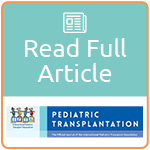The use of VADs as a bridge to transplant among children is increasing and is associated with high resource utilization. We know implanting a VAD before a child reaches a state of cardiogenic shock is clearly associated with improved outcomes. However, beyond this, there is sparse evidence to guide the timing of VAD implant and patient selection in pediatrics. Specifically, should a VAD be implanted in a pediatric patient who is relatively stable on inotropes?
To explore this question, we performed a cost-effectiveness analysis comparing continuous flow VAD implant to a watchful waiting approach in older children with stable, inotrope-dependent heart failure due to dilated cardiomyopathy: “Cost-effectiveness of implantable ventricular assist devices in older children with stable, inotrope-dependent dilated cardiomyopathy.”
We found that the average incremental cost-effectiveness ratio (or ICER)—which is the ratio of the difference in costs and benefits of early VAD implantation versus watchful waiting on chronic inotropy—was just over 160,000 US dollars per quality adjusted life year or QALY gained. This incremental cost-effectiveness ratio is higher than the commonly accepted threshold of cost-effectiveness in the US, which is 100,000 dollars per QALY. This ICER is also slightly higher than what the ACC and AHA consider to be “intermediate value care” which is set at 150,000 dollars per QALY. This finding suggests that for stable, inotrope-dependent children with dilated cardiomyopathy, a watchful waiting approach instead of early VAD implantation may provide more value for the healthcare system.
In our analysis, we also adjusted the parameters to see which had the biggest impact on cost-effectiveness. We showed that VADs can reach the cost-effectiveness threshold if implantation and post-implant hospitalization costs decrease by around 50%. Additionally, VADs would be the clear, cost-effective option if the risk of recurrent hospitalizations or death while waiting on chronic inotropic therapy is estimated to be significantly higher than expected.
Improving the costs of implant and discharge rate and more accurately assessing waiting list risk should be areas of focus going forward. With steadily increasing experience, innovation and collaboration across the field of pediatric VADs, the overall outcomes and cost-effectiveness of VAD support should continue to improve.
It is important to note that a cost-effectiveness analysis is just one of many factors that should inform clinical decision-making and should not be utilized in isolation. Also for exceptional, severe, rare conditions like pediatric heart failure, different value thresholds are often considered and higher-resource therapies are often deemed acceptable and worthwhile.
The analysis was published in Pediatric Transplantation. ACTION leaders apart of this analysis include:
David Peng and Kurt Schumacher, C.S. Mott Children’s Hospital
CITATION
Avanceña ALV, Hutton DW, Lee J, Schumacher KR, Si MS, Peng DM. Cost-effectiveness of implantable ventricular assist devices in older children with stable, inotrope-dependent dilated cardiomyopathy. Pediatr Transplant. 2021 Jan 22:e13975. doi: 10.1111/petr.13975. Epub ahead of print. PMID: 33481355.

